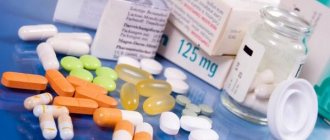Mechanism of development of acute pancreatitis
Pancreatic juices exit into the duodenum from the common pancreatic duct.
It also contains the outlet of the gallbladder. Gallstones can advance and block the common bile duct. However, in this case, the large pancreatic duct is also blocked. In this case, pancreatic enzymes, not finding a way out, remain inside it, stagnate, cause inflammation and swelling, which leads to self-digestion of the gland. Alcohol abuse also slows down the outflow of enzymes, which leads to stagnation and swelling of the pancreas. This is how pancreatitis develops, the nature of which, in fact, is not infectious in nature. Even if the gallbladder is only inflamed, the risk of developing pancreatitis is still high, because these organs have a common excretory duct.
With pancreatitis, fluid from biologically active substances and enzymes begins to accumulate in the abdominal cavity. It comes into contact with the peritoneum - the connective tissue that lines the abdominal cavity and covers the internal organs.
Important! In this case, the peritoneum also becomes inflamed, and a severe complication of pancreatitis develops - peritonitis. In addition, intestinal microflora penetrates into the fluid through the lymphatic tract from the intestine, which increases inflammation of the peritoneum. When complicated by peritonitis, the disease ends in death in 70% of cases.
Alternative Treatment Options
An integrated approach allows you to normalize and restore the functioning of the pancreas in the shortest possible time. For chronic pancreatitis, medications are prescribed and a treatment menu is drawn up. In case of exacerbation, seek emergency medical attention and apply a cold compress to the upper abdomen. The first 2-3 days are indicated by fasting and bed rest.
Drug therapy is designed to eliminate attacks of pain. During an exacerbation, the patient experiences severe pain, which is relieved by drugs such as No-shpa® and Papaverine®.
The use of aspirin and non-steroidal anti-inflammatory drugs is excluded, as they irritate the mucous membrane and thin the blood, which leads to internal bleeding.
Metronidazole® is recommended as an additional antimicrobial drug. Metronidazole® for pancreatitis is usually prescribed in particularly severe cases, when necrotic changes have affected about 30% of the pancreas.
Read further: Effective metronidazole® analogues from 6 rubles
Taking antisecretory drugs, such as omeprazole®, can eliminate acid-related gastrointestinal diseases by reducing the production of hydrochloric acid.
Taking enzyme preparations during the acute period is strictly prohibited.
Enzyme replacement therapy is prescribed to correct the symptoms of exocrine insufficiency, only after the acute inflammatory process has subsided.
The duration of therapy and doses of drugs should be selected only by the attending physician. Changing prescriptions on your own can cause serious harm to health, as well as provoke a new attack of pancreatitis.
During replacement therapy, enzymes are taken, for example, Mezim® or Festal®, which improve the digestion process and facilitate the functioning of the pancreas. If inflammation is accompanied by disturbances in water-salt metabolism, isotonic saline solutions are prescribed.
Surgery is an indirect and direct method of treating inflammation of the pancreas. In the first case, operations are performed on the organs of the gastrointestinal tract, and in the second, drainage of cystic tumors, removal of gallstones or parts of the affected organ are performed. Surgical treatment is used when conservative methods are ineffective and there are severe complications.
Patients must adhere to a strict diet and small meals. You need to eat at least five times a day. During the period of remission, consumption of foods with a high protein content is indicated. A strict diet that excludes spicy and fatty foods, cocoa, coffee and carbonated drinks will speed up the healing process. Healing mineral waters have a beneficial effect on the digestive tract.
Read more: How to quickly remove antibiotics from the body after treatment
- About
- Latest Posts
Edited by A. Chernenko
Infectious disease doctor of the highest category with many years of experience. Specialist in the field of therapy of infectious diseases of various etiologies, methods of laboratory diagnostics of biomaterial.
How does taking antibiotics affect the digestive system?
In all cases, inflammatory disease of the pancreas is a severe pathology that is difficult to correct. Pancreatitis cannot be completely cured due to the rapid death of cells during an acute process or their replacement with connective or adipose tissue. In addition, any inflammation can be complicated by life-threatening conditions, which develop in 20% of cases of existing pancreatitis.
In order to treat the inflammatory process in the diseased pancreas and other digestive organs affected by its destruction, antibiotic therapy is prescribed. Sometimes this therapy is used if there is a threat of infection spreading to neighboring digestive organs. Treatment with these drugs is used to prevent severe complications of pancreatitis:
- abscess;
- retroperitoneal phlegmon;
- peritonitis;
- sepsis.
Indications also include:
- rupture of the common pancreatic duct;
- bile stasis.
But today, the use of antimicrobial drugs for prophylactic purposes is considered inappropriate, since in these cases their effectiveness has not been proven: they do not reduce mortality when used prophylactically, despite a decrease in the incidence of infection, but the toxic effect on the body is significant. For the edematous form of pancreatitis, antibacterial agents are also not used. They are prescribed when the first signs of infection appear: fever, nausea, diarrhea, and sometimes vomiting.
When prescribing antibiotics, it is necessary to consider:
- the ability of the drug to penetrate the blood-brain barrier into the pancreas and neighboring organs;
- sensitivity of the suspected pathogenic agent to the selected drug;
- side effects that a certain medicine may cause.
In each specific case, antibiotics are prescribed individually.
Of the digestive organs, the pancreas and stomach are most sensitive to the effects of antibiotics. Violation of their functions develops due to a sharp decrease in normal microflora and a significant increase in pathogenic microbes.
Objective indicators of pathological changes in the gastrointestinal tract after taking antibiotics include the occurrence of abdominal pain of various types and locations, bloating, nausea, vomiting, and diarrhea. To reduce the risk of their occurrence, probiotics are prescribed.
The liver is also susceptible to antibacterial agents. In a healthy person, it does not react to medications, neutralizing toxic substances. But with impaired functions, the clinical manifestations of its damage are in the mouth, heaviness in the right hypochondrium, and nausea. To prevent the toxic effect of medications on liver tissue, hepatoprotectors are additionally prescribed.
When are antibiotics prescribed?
In 20% of victims who are faced with pancreatic disease, the pathology is severe. The situation worsens in the case of an incorrect diagnosis, errors in diet and untimely visits to the doctor.
For inflammation of the pancreas, treatment consists of taking antispasmodics, analgesics and anticholinergic drugs. In addition, the patient is advised to fast for 2 days and drink plenty of fluids. Forced diuresis is effective. An infusion method is necessary to eliminate changes in water and electrolyte balance.
In the basic version, in severe cases of pancreatitis, treatment is carried out with antisecretory antienzyme methods. In addition, patients take antioxidants and antihypoxants. If the pain process is severe, prolonged epidural analgesia is prescribed.
When the disease is mild, early use of antimicrobial drugs for the pancreas is inappropriate, since it is impossible to reduce the threat of putrefactive complications.
Antibacterial drugs are prescribed for complex pancreatitis, when there is a threat of infection - the introduction of bacteria, due to the activation of opportunistic flora. Then the patient needs to take antibiotics that have affinity for pancreatic tissue.
pancreas
As measures to prevent purulent complications, combinations of cephalosporins with metronidazole, fluoroquinolones, and fourth-line antibiotics are more effective.
In the acute development of the disease, therapy is prescribed with the use of antimicrobial medications if pancreatic necrosis is confirmed and there is a threat of formation.
- Sepsis.
- Peritonitis.
- Retroperitoneal phlegmon.
- Ulcer of the head of the organ.
The drugs are also used if:
- there is cholangitis;
- stopping bile when the gallbladder is full of stones;
- there are many cysts when inflammation is present and the gland is suddenly affected.
In the case of a chronic form, antimicrobial drugs are prescribed when:
- peripancreatitis using ultrasound, computed tomography;
- acute form of cholecystitis, cholangitis, growth in the bladder of a chronic course;
- excessive bacterial growth in the large intestine.
What effect do antibiotics have on the pancreas? Antibacterial agents are strong medications that make it possible to overcome the inflammatory phenomena occurring in the tissues of the gland. Sometimes these medications don't help. This is characterized by the fact that inflammation continues to develop in the gland, affecting the tissue. This problem has already been solved with the help of surgical treatment.
a type of antibiotic
If you take antibacterial medications to treat pancreatitis, the patient will encounter a number of side effects.
- The intestinal microflora will be disrupted, which will lead to nausea, vomiting, and diarrhea.
- The composition of the blood will be disrupted.
- Damage to the kidneys and liver will occur.
- Allergic manifestations in the form of urticaria, anaphylactic shock.
- Damage to the nervous system.
- Hemolytic anemia.
- Suppuration will appear in the area where the antibiotic was administered.
For this reason, self-administration of drugs is prohibited; each drug is prescribed only by a doctor in the required dosage to each patient separately.
When you need them
Antibiotics for pancreatitis in adults are used as a last resort when there is a risk of infection. They help stop the inflammatory process, which spreads to other organs of the gastrointestinal tract. Such drugs are prescribed if the patient experiences severe pain that is not relieved by conventional painkillers, with an increase in temperature, and also if there is a suspicion of the development of a bacterial infection.
In severe cases of pancreatitis, serious complications may develop, for example, pancreatic necrosis, cholangitis, duct rupture, and bile stagnation. Such conditions can lead to sepsis or peritonitis. To prevent these complications, antibacterial drugs are prescribed.
Proper treatment of pancreatitis with antibiotics helps stop the inflammatory process, preventing it from spreading to other organs. They are especially often prescribed for the acute course of the disease. In this case, the inflammatory process and destruction of pancreatic tissue often leads to the development of bacterial flora. The use of antibiotics helps prevent peritonitis and quickly stops inflammation.
But for chronic pancreatitis, such medications are rarely prescribed. Usually the inflammation in this case is aseptic and develops slowly. Only sometimes it is accompanied by complications. Antibiotics cannot be used for prophylactic purposes, otherwise bacterial flora resistant to any drugs may develop. They are prescribed only in the presence of infection, inflammation of the gallbladder, obstruction of the outflow of bile, or risk of damage to the ducts.
Antibiotics can be used for pancreatitis only as prescribed by a doctor if there is an infection or if there is a risk of developing it
Antibiotics for the treatment of pancreatitis
Antibiotics for cholecystitis or pancreatitis are prescribed to suppress infection and relieve the inflammatory process.
Antibacterial treatment is justified due to the presence of a high number of microorganisms - important participants in the digestive process, which, during the inflammatory process, can play for the opposing team and worsen the patient’s condition.
However, when agreeing to take any antibiotics or any treatment in general, it is important to remember the difficulties in making a correct diagnosis in modern medicine of the post-Soviet school. . only a very competent specialist can take into account all the subtleties of the effects of antibiotics on the body (for example, adaptation of flora to drugs), so relying on reviews when choosing antibiotics is not the best idea; When agreeing to antibiotics, as with any other treatment, you need to make sure the diagnosis is accurate.
- only a very competent specialist can take into account all the subtleties of the effects of antibiotics on the body (for example, adaptation of flora to drugs), so relying on reviews when choosing antibiotics is not the best idea;
- When agreeing to antibiotics, as with any other treatment, you need to make sure the diagnosis is accurate.
Of course, it is not so easy to comply with these conditions: it is easy for a specialist to get rid of the patient with difficult to pronounce words or outlining gloomy prospects, after which the patient agrees to any treatment, just to relieve himself of responsibility for the possible consequences of delay in taking drugs for pancreatitis.
However, the patient is more interested in his own health than anyone else and must defend his own interests.
Who if not me? This is the first question that is important to ask yourself and understand that no doctor is more interested in your well-being than you.
Ask questions and observe the doctor's reaction. Does the doctor try to answer clearly, does he intimidate, does he offer alternatives?
Video:
Read medical literature about your pathology. You may not understand everything, but even certain points may coincide with or contradict the opinion of your attending physician.
Consult in other clinics with other specialists who are not interested in supporting your doctor's version.
Types and forms of antibiotics
There are several main groups of antibacterial drugs. They differ in different mechanisms of action. Most antibiotics are effective against many bacteria at once, others only against certain types. There are also drugs that destroy pathogenic microorganisms and suppress their reproduction.
For pancreatitis, the choice of antibacterial agent depends on the degree of microbial contamination, the form of inflammation, and the condition of the patient’s body as a whole.
Both potent antibiotics and drugs that are concentrated in the pancreatic tissues in minimally suppressive doses can be prescribed .
The preferred form of release is injection. Types of antibiotics used for pancreatitis:
- Maximum effective. The class of fluoroquinolones (Pefloxacin), carbapenems (Imipenem), 3-4 generation cephalosporins (Cefepime, Cefotaxime) in combination with Metronidazole, Mezlocillin, Clindamycin.
- Creating minimum therapeutic concentrations. Protected penicillins (Ticarcillin/clavulanate, Tazocin), 3rd and 4th generation cephalosporins (Cefepime, Cefotaxime).
Attention! First generation cephalosporins (Cefazolin), aminoglycosides (Amikacin), aminopenicillins (Amoxicillin) and drugs of the tetracycline group (Tetracycline) are not used for pancreatitis due to poor penetration.
When is it necessary to take antibiotics?
In most patients, pancreatitis is severe. Most often, this is due to an incorrect diagnosis or late contact with a specialist. Nutrition also plays an important role. If you do not follow the diet prescribed by your doctor, exacerbations of the disease often occur, which are accompanied by severe pain and an increased risk of serious complications.
As a rule, in case of exacerbation of chronic pancreatitis or development of acute pancreatitis, antispasmodics are prescribed, which eliminate spasms and improve the passage of pancreatic juice through the ducts of the gland, painkillers and anticholinergic therapy are used
During this period, it is important to follow a fasting diet and drink as much water as possible to increase diuresis. And cholinotic therapy ensures restoration of water and electrolyte balance at this moment
Rules and features of taking antibiotics
Therapy with potent antibiotic drugs requires compliance with a number of recommendations:
- the maximum effect can be achieved by intravenous or intramuscular administration of the drug;
- course of treatment from seven days to two weeks. Exceeding 14 days of antibiotic therapy is not recommended;
- It is recommended to take medications only with clean still water;
- Under no circumstances should you adjust the dosage yourself;
- lack of improvement within three days indicates that the pathogen is resistant to this type of antibiotic, so the medicine should be replaced;
- You should not stop taking the drug as soon as the condition improves.
- to consolidate the result, therapy should continue for another 2-3 days;
- Equal periods of time must be maintained between doses of the medication to maintain a constant concentration of the drug in the blood.
- Antibiotics for pancreatitis and cholecystitis are prescribed only by a doctor.
Common drugs
What antibiotics are needed in each specific case can only be determined by a doctor. Not all such drugs act equally effectively on the pancreas. A combination of several agents may be required to successfully resolve the infection.
In acute pancreatitis, it is more effective to use antibiotics by injection
Metronidazole is most often used for complex treatment. This is an effective broad-spectrum antimicrobial drug, which is most active in the gastrointestinal tract. It is best to combine it with fluoroquinolones or cephalosporins.
The choice of drug depends on the severity of the pathology and the presence of complications. Usually, at the initial stage, weaker drugs are sufficient; in this case, Biseptol, Oletetrin, Bactrim, Tetracycline, Amoxicillin are prescribed. In case of acute inflammation and spread of infection, stronger drugs are needed: Doxycycline, Kanamycin, Tsiprolet, Ampicillin. If they do not help or the inflammation is caused not by bacteria, but by other microorganisms, Sumamed, Abactal or Metronidazole are prescribed in combination with broad-spectrum antibiotics.
During exacerbation
Acute pancreatitis rarely begins immediately with an infectious process. Therefore, antibacterial drugs are usually prescribed for 2-3 weeks of illness.
But it is very important to start taking them as early as possible in case of a sharp exacerbation of the pathology with high fever and severe pain. In such cases, antibiotics are most often used by injection - intramuscular or intravenous.
Sometimes it is necessary to inject drugs directly into the abdominal cavity to prevent peritonitis.
Sumamed is one of the most effective antibiotics for pancreatitis
In case of chronic course
In chronic pancreatitis, there is rarely a need to use antibiotics. They are usually prescribed after a comprehensive examination if there is an infection or inflammation has spread to surrounding organs. Antibiotics are selected individually in this case, depending on the symptoms manifested and the severity of the disease.
Most often, the following drugs are prescribed for chronic pancreatitis:
- Levomycetin is effective for severe diarrhea;
- Tsiprolet prevents purulent process and peritonitis;
- for cholecystitis, Amoxicillin is needed;
- Amoxiclav quickly removes any bacterial infection.
Medicines in tablets
This form of antibacterial agents is used for moderate severity of the disease, if there is a risk of infection, but there are no complications on the stomach and intestines. Tablets are taken 1-3 times a day for 5-10 days. Be sure to follow the dosage and treatment regimen prescribed by your doctor. Most often, the following drugs are prescribed for pancreatitis:
- Amoxicycline is a broad-spectrum antibiotic that is well absorbed from the gastrointestinal tract and prevents the development of complications;
- Amoxiclav is a combination of Amoxicycline with clavulanic acid; its advantages include good tolerability and the need to take it only once a day;
- Sumamed or Azithromycin are effective against a large number of microorganisms;
- Tsiprolet is a broad-spectrum drug that is effective for the treatment of purulent inflammation.
Quite often, Ceftriaxone injections are prescribed for pancreatitis.
Injections
In acute pancreatitis with bacterial infection, antibiotic injections are necessary. Strong drugs are used for these purposes, which begin to act almost immediately after the first administration. The very next day, the inflammation subsides, the patient’s temperature decreases and overall health improves.
- Cefotaxime or Cefoperazone are effective broad-spectrum antibiotics that have bactericidal properties and prevent complications after surgery;
- Abaktal is often used for acute inflammation of the pancreas, since it exhibits the greatest activity in the gastrointestinal tract, the drug is effective even when other drugs have not worked;
- Vancomycin is used for serious infections, sepsis, and when other drugs are ineffective;
- Ceftriaxone effectively destroys most bacteria and is well tolerated by patients, so it can be used even in children;
- Ampiox or Ampicillin quickly relieve inflammation and alleviate the course of the pathology.
All antibacterial drugs can only be used as prescribed by a doctor. Unauthorized choice of medication or change in dosage can lead to serious complications.
List of drugs used
If there is inflammation in the pancreas, doctors recommend antibiotics, but only if there are reasonable indications for this. These drugs may be:
- Amoxiclav;
- Biseptol;
- Abaktal;
- Amoxicillin;
- Bactrim;
- Vancocin;
- Tienam;
- Tsiprolet and others.
For pancreatitis that requires immediate action, specialists usually use Ceftriaxone and one of the drugs with a wide range of actions in the form of De-Nol, Kvamatel, Omez, Cerucal, Ultrop. In a number of situations, Atropine is prescribed; when prescribed, the tablet form is advantageous.
Rules for taking antibiotics for pancreatitis
In more than 20% of people, inflammation of the pancreas occurs in a complicated form, which makes it necessary to relieve the main symptoms.
Treatment of pancreatitis with antibiotics involves following certain rules:
- Prescriptions are carried out by doctors in the event of the development of infections, as well as in the event of severe pain that cannot be neutralized by other medications.
- It is possible to achieve a more pronounced therapeutic effect when using antibiotics by injection.
- Recommended courses of treatment have a duration ranging from 7 to 14 days. Injections are given two per day.
- If symptoms of parapancreatitis are detected, a drug such as Pefloxacin is prescribed.
- The sooner you start treating pancreatitis with antibiotics, the better. This applies to any form of the disease, regardless of the nature of its course.
Indications and contraindications for taking Amoxiclav for pancreatitis
is prescribed for pancreatitis and various kinds of infectious diseases caused by pathogenic bacteria. But often this composition is used in the treatment of acute respiratory infections. The drug helps reduce the severity of symptoms of the disease and shortens its duration.
Amoxiclav has few contraindications. It is even prescribed to infants and women during pregnancy (under the supervision of a medical specialist). The main contraindication to taking the drug is intolerance to penicillins and alternative beta-lactam antibiotics on an individual basis.
The use of Amoxiclav for pancreatitis largely depends on the current condition of the patient’s kidneys.
Important! Patients with renal failure should take reduced doses of Amoxiclav compared to ordinary people.
Children under twelve years of age are not prescribed Amoxiclav in tablets; a suspension is intended for them. When breastfeeding a baby, the medication can be used after consultation with a medical specialist.
Chronic form
Antibiotics for chronic pancreatitis are prescribed for:
- parallel development of cholangitis;
- the occurrence of peripancreatitis;
- development of gallstones or kidney stones;
- failure of internal organs - renal or cardiac.
Other antibiotics are prescribed to temporarily relieve discomfort and maintain health and digestion. Treatment of chronic pancreatitis rarely includes the prescription of antibiotics - in exceptional cases, when parallel inflammation covers the gland, affects the tissue, and threatens to cause an acute attack.
In case of inflammation of the gallbladder, antibiotics are prescribed without fail.
What medications should you take?
It is not recommended to prescribe medications on your own. To treat diseases that occur in parallel with chronic pancreatitis, the following drugs are used:
- Cefuroxime - intravenously or intramuscularly. Course of treatment: week, dosage time – 3 times a day, 1 g of medicinal substance;
- Cephobid – twice a day, 1 g of medicinal substance;
- Cefoperazone;
- Cefixime;
- Ampiox – inside the muscle. The course of treatment is a week, 2 g four times a day;
- Amoxicillin;
- Augmentin.
The names of the drugs are similar (the action is also similar in most cases), and the differences are also determined: the chemical composition and concentration of the active substance.
The first group of drugs provided in the list refers to cephalosporins, and the second to penicillins. The dosage or route of administration differs depending on the individual characteristics of the patient and the stage of development of the disease. You should consult your doctor.
Prescribing probiotics for prevention purposes
Prescribing antibiotics for chronic pancreatitis over long courses is not recommended. The influence of drugs also extends to beneficial microorganisms: they are destroyed. Patients with chronic pancreatitis are recommended to take:
- bifidumbacterin;
- bifiform;
- Linux;
- lactobacterin;
- Lactiale.
The diet should include foods rich in bifidobacteria and lactobacilli, containing low-fat milk - yogurt, curdled milk, fermented baked milk and kefir.
What determines the purpose of the drug?
Antibiotics are used to fight infection. Infections with pancreatitis occur constantly: the intestines, gallbladder, and kidneys can become inflamed.
Bacteria enter the body and begin to settle in tissues and environments. When the pancreas becomes inflamed, immunity necessarily decreases. Metabolism deteriorates, substances that support immunity do not work properly.
The prescription of antibiotics depends directly on the type of bacteria causing the infection. List of popular anti-infective agents against anaerobic bacteria:
- Ampicillin (used together with Sulbactam);
- Augmentin;
- Cephalosporins;
- Metronidazole is sometimes prescribed additionally.
Effective and commonly prescribed antimicrobial agents
In acute cases of the disease, broad-spectrum antibiotics are prescribed: fluoroquinolones, synthetic penicillin derivatives and cephalosporins. Let's look at each drug in detail.
Cefoperazone ® is administered intravenously. It is highly effective against a wide range of microorganisms and has a pronounced bactericidal effect. Used for seven to 10 days. It is also used as an antibacterial cover in the surgical treatment of pancreatitis and its complications.
Ceftriaxone ® is a 3rd generation cephalosporin antibiotic that has a bactericidal effect. The course of treatment for pancreatitis using Cefriaxon is about a week. The drug is administered intravenously twice a day.
Amoxiclav ® is a combination drug produced in tablet form. It contains amoxicillin and clavulanic acid. For effective therapy, it is enough to drink one tablet once a day. The duration of the course is approximately 7 days.
Pefloxacin ® or abactal ® is a broad-spectrum antibiotic belonging to the class of fluoroquinolones. It has a high affinity for pancreatic tissues. The most effective is infusion administration (intravenous drip, over an hour) twice a day.
Vancocin ® is an antibiotic, an antibiotic belonging to the group of glycopeptides. Used for sepsis, in case of ineffectiveness of beta-lactams. The drug is specially designed to treat infections. The active ingredient is vancomycin hydrochloride. One bottle contains 0.5 or 1 gram of this substance. The antibiotic is available in powder form.
Doxycycline ® is administered intravenously or intramuscularly. When taken orally, Doxycycline ® is almost completely absorbed from the gastrointestinal tract. The course of treatment lasts no more than 10 days.
Acute form
Previously, antibiotics were prescribed to patients diagnosed with acute pancreatitis. It was believed that the tablets had a good preventive effect, protecting the body from the occurrence of parallel diseases. Clinical studies have provided optimistic data stating that after taking such drugs, the number of deaths among patients with pancreatitis decreased. This meant that the risk of an inflammatory infection while taking medications was sharply reduced, which means that the disease progressed more calmly.
Common medications for acute illness:
- Cefotaxime;
- Abaktal;
- Ceftriaxone;
- Vancocin;
- Tienam;
- Amoxiclav.
Later it was confirmed: the tablets do indeed reduce the risk of infection (antibiotics of different spectrums are used), but the tablets do not affect the lethality. Even after the end of an attack of acute pancreatitis, drugs are not prescribed, allowing the pancreas to rest. Re-appointment occurs if any of the internal organs experience failure, which indicates the possibility of infection and the need to fight.
The earlier the anti-infective medicine is prescribed, the more pronounced the effect of the drugs. There are situations when antibiotics are mandatory: suppose peritonitis develops in parallel with acute pancreatitis. Then prescribing antibiotics is vital.
Several principles for prescribing antibiotics
The prescription of antibiotics is preceded by many factors; the drug is not prescribed by a doctor unless necessary. You should also be aware of the accompanying symptoms:
- excessively acute pain that is difficult to bear and impossible to relieve with other medications;
- the maximum effect is achieved by administering the medicine by injection;
- the maximum course of injections is 2 weeks, 2-4 times a day;
- when peripancreatitis develops, the patient is prescribed Pefloxacin and Azithromycin;
- when there are potential signs that the disease will be severe (possibly based on the severity of symptoms or other signs - genetics, medical history). Antibiotics will need to be prescribed sooner.
Self-medication should not be carried out; a doctor's advice is necessary. Unreasonable use of antibiotics leads to the opposite effect: due to the complete destruction of intestinal microflora bacteria by the drug, the beneficial ones are also destroyed, which worsens the already undermined health of the patient.
New generation drugs
Ceftriaxone is a third-generation antibiotic that can inhibit the synthesis of cell walls of bacteria sensitive to the active substance. It has a wide spectrum of action and is used in case of complications, as well as in preventive measures for patients with pancreatitis. It is used both intramuscularly and intravenously. Contraindications for use are:
- increased sensitivity to antibiotics;
- first 3 months of pregnancy;
- breast-feeding;
- liver and kidney failure.
It is important that Ceftriaxone is incompatible with other antibiotics of the same volume.
Thus, there are quite a lot of antibacterial drugs that can be used to treat pancreatitis and its complications, and they all have a wide spectrum of action. But this group of drugs can have a positive therapeutic effect and at the same time cause harm, for example, to the intestinal microflora, so many specialists prescribe probiotics to prevent such consequences.











